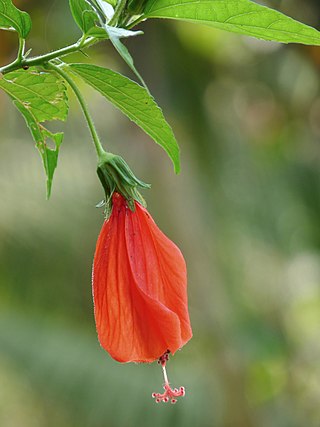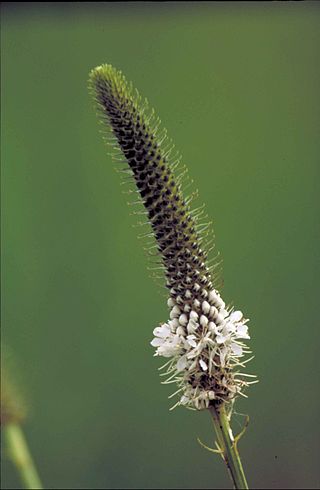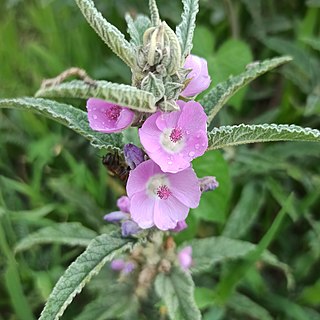
Callirhoe is a genus of flowering plants in the mallow family, Malvaceae. Its nine species are commonly known as poppy mallows and all are native to the prairies and grasslands of North America. Of the nine species, some are annuals while others are perennial plants.

Abutilon is a large genus of flowering plants in the mallow family, Malvaceae. It is distributed throughout the tropics and subtropics of the Americas, Africa, Asia, and Australia. General common names include Indian mallow and velvetleaf; ornamental varieties may be known as room maple, parlor maple, or flowering maple. The genus name is an 18th-century Neo-Latin word that came from the Arabic ’abū-ṭīlūn, the name given by Avicenna to this or a similar genus.

Mirabilis is a genus of plants in the family Nyctaginaceae known as the four-o'clocks or umbrellaworts. The best known species may be Mirabilis jalapa, the plant most commonly called four o'clock.

Cercocarpus, commonly known as mountain mahogany, is a small genus of at least nine species of nitrogen-fixing flowering plants in the rose family, Rosaceae. They are native to the western United States and northern Mexico, where they grow in chaparral and semidesert habitats and climates, often at high altitudes. Several are found in the California chaparral and woodlands ecoregion.

Malvaviscus is a genus of flowering plants in the mallow family, Malvaceae. Common names for species in this genus include Turk's cap mallow, wax mallow, sleeping hibiscus, and mazapan. It belongs to a group of genera that differ from the closely related Hibiscus in possessing a fruit divided into 5 separate parts, and having a style surmounted by 10, rather than 5, capitate or capitellate stigmas. Among those genera Malvaviscus is distinguished by having auriculate petals and red, fleshy fruits. The generic name is derived from the Latin words malva, meaning "mallow," and viscus, which means "sticky," referring to the mucilaginous sap produced by members of the genus. The fruit can be used to make jelly or syrup. Both the fruit and flowers are used to make herbal teas.

Camissonia, sometimes commonly known as sun cup or sundrop, is a genus of annual and perennial plants in the evening primrose family Onagraceae. A total of 12 species are known, nearly all from western North America, especially in the California Floristic Province, but also one from South America. Previous circumscriptions of the genus had recognized up to 62 species before it was split among other closely related genera.

Claytonia is a genus of flowering plants native to Asia, North America, and Central America. The vitamin-rich leaves can be eaten raw or cooked, and the tubers can be prepared like potatoes.

Physocarpus, commonly called ninebark, is a genus of flowering plants in the family Rosaceae, native to North America and northeastern Asia.

Sphaeralcea incana, with the common names gray globemallow and soft globemallow, is a desert plant in the mallow family (Malvaceae).

Dalea is a genus of flowering plants in the legume family, Fabaceae. Members of the genus are commonly known as prairie clover or indigo bush. Its name honors English apothecary Samuel Dale (1659–1739). They are native to the Western hemisphere, where they are distributed from Canada to Argentina. Nearly half of the known species are endemic to Mexico. Two species of Dalea have been considered for rangeland restoration.

Pectis is a genus of flowering plants in the family Asteraceae described as a genus by Linnaeus in 1759.

Iliamna is a small genus of flowering plants in the mallow family, endemic to North America. It is related to the bush mallows of California (Malacothamnus) and to Phymosia of Mexico, Central America and the Caribbean. These perennial herbs are known commonly as wild hollyhocks and sometimes as globe mallows, Kankakee mallow, Kankakee globe mallow, and Streambank wild hollyhock. More often, the latter terms refer to members of the genus Sphaeralcea, which belong, like Iliamna, to the "typical" mallow tribe (Malveae) of the mallow and hibiscus subfamily Malvoideae. The name of the genus, proposed by Edward Lee Greene, appears to be a reference to Iliamna Lake in Alaska, even though the genus Iliamna does not occur in Alaska

Perityle is a genus of flowering plants in the daisy family. They are known generally as rock daisies.

Sphaeralcea gierischii, Gierisch's globemallow or Gierisch mallow, is an endangered species of flowering plant in the mallow family, Malvaceae. It is native to the western United States, where it is known only from Utah and Arizona. It was described in 2002.

Malvaviscus arboreus is a species of flowering plant in the hibiscus family, Malvaceae, that is native to the American South, Mexico, Central America, and South America. The specific name, arboreus, refers to the tree-like appearance of a mature plant. It is now popular in cultivation and goes by many English names including wax mallow, Turk's cap (mallow), Turk's turban, sleeping hibiscus, manzanilla, manzanita, ladies teardrop and Scotchman's purse; many of these common names refer to other, in some cases unrelated, plants. Its flowers do not open fully and help attract butterflies and hummingbirds.

Sphaeralcea angustifolia is a species of flowering plant in the mallow family known by the common names copper globemallow and narrow-leaved globemallow. It is native to the southwestern United States as well as northern and central Mexico, where it grows in desert and plateau habitat. It produces many erect stems, approaching three meters in maximum height. It is woolly or felt-like in texture. The gray-green leaf blades are lance-shaped and measure up to about 5 cm long. They have wavy or slightly lobed edges. The leafy inflorescence bears several flowers each with five wedge-shaped orange petals just under 1 cm in length, and yellow anthers.


















